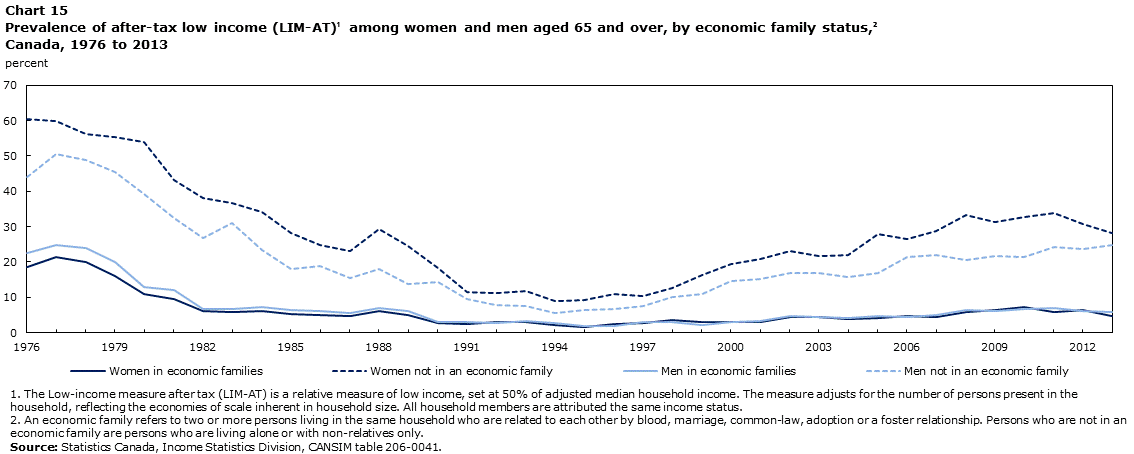Chart 15
Prevalence of after-tax low income (LIM-AT)1 among women and men aged 65 and over, by economic family status2, Canada, 1976 to 2013

Description for Chart 15
| Women in economic families | Women not in an economic family | Men in economic families | Men not in an economic family | |
|---|---|---|---|---|
| 1976 | 18.5 | 60.4 | 22.5 | 44.1 |
| 1977 | 21.3 | 59.9 | 24.9 | 50.6 |
| 1978 | 19.9 | 56.1 | 24.0 | 49.0 |
| 1979 | 15.9 | 55.5 | 20.1 | 45.5 |
| 1980 | 10.9 | 54.0 | 12.9 | 39.1 |
| 1981 | 9.6 | 43.3 | 12.0 | 32.4 |
| 1982 | 6.2 | 38.2 | 6.8 | 26.8 |
| 1983 | 5.9 | 36.8 | 6.7 | 31.0 |
| 1984 | 6.1 | 34.2 | 7.2 | 23.3 |
| 1985 | 5.2 | 28.3 | 6.4 | 17.9 |
| 1986 | 5.1 | 24.9 | 6.2 | 18.9 |
| 1987 | 4.8 | 23.2 | 5.6 | 15.4 |
| 1988 | 6.2 | 29.4 | 7.1 | 17.9 |
| 1989 | 5.0 | 24.4 | 6.1 | 13.7 |
| 1990 | 2.8 | 18.2 | 3.0 | 14.2 |
| 1991 | 2.5 | 11.6 | 3.0 | 9.6 |
| 1992 | 2.9 | 11.3 | 2.8 | 7.9 |
| 1993 | 2.9 | 11.7 | 3.2 | 7.6 |
| 1994 | 2.2 | 8.9 | 2.6 | 5.5 |
| 1995 | 1.5 | 9.3 | 2.0 | 6.4 |
| 1996 | 2.3 | 10.8 | 2.0 | 6.6 |
| 1997 | 2.6 | 10.3 | 2.9 | 7.4 |
| 1998 | 3.6 | 12.7 | 3.0 | 10.0 |
| 1999 | 3.0 | 16.3 | 2.2 | 11.0 |
| 2000 | 3.1 | 19.5 | 3.1 | 14.6 |
| 2001 | 3.0 | 20.7 | 3.4 | 15.3 |
| 2002 | 4.4 | 23.0 | 4.8 | 16.9 |
| 2003 | 4.3 | 21.6 | 4.4 | 16.9 |
| 2004 | 3.9 | 21.9 | 4.1 | 15.7 |
| 2005 | 4.1 | 28.0 | 4.7 | 17.0 |
| 2006 | 4.7 | 26.5 | 4.4 | 21.5 |
| 2007 | 4.5 | 28.7 | 5.1 | 22.1 |
| 2008 | 5.8 | 33.4 | 6.3 | 20.5 |
| 2009 | 6.3 | 31.3 | 6.0 | 21.6 |
| 2010 | 7.3 | 32.8 | 6.6 | 21.4 |
| 2011 | 5.8 | 34.0 | 7.1 | 24.3 |
| 2012 | 6.3 | 30.7 | 6.1 | 23.8 |
| 2013 | 4.7 | 28.2 | 5.7 | 24.7 |
The Low-income measure after tax (LIM-AT) is a relative measure of low income, set at 50% of adjusted median household income. The measure adjusts for the number of persons present in the household, reflecting the economies of scale inherent in household size. All household members are attributed the same income status.
An economic family refers to two or more persons living in the same household who are related to each other by blood, marriage, common-law, adoption or a foster relationship. Persons who are not in aneconomic family are persons who are living alone or with non-relatives only.
Source:
Statistics Canada, Income Statistics Division, CANSIM table 206-0041.
- Date modified: